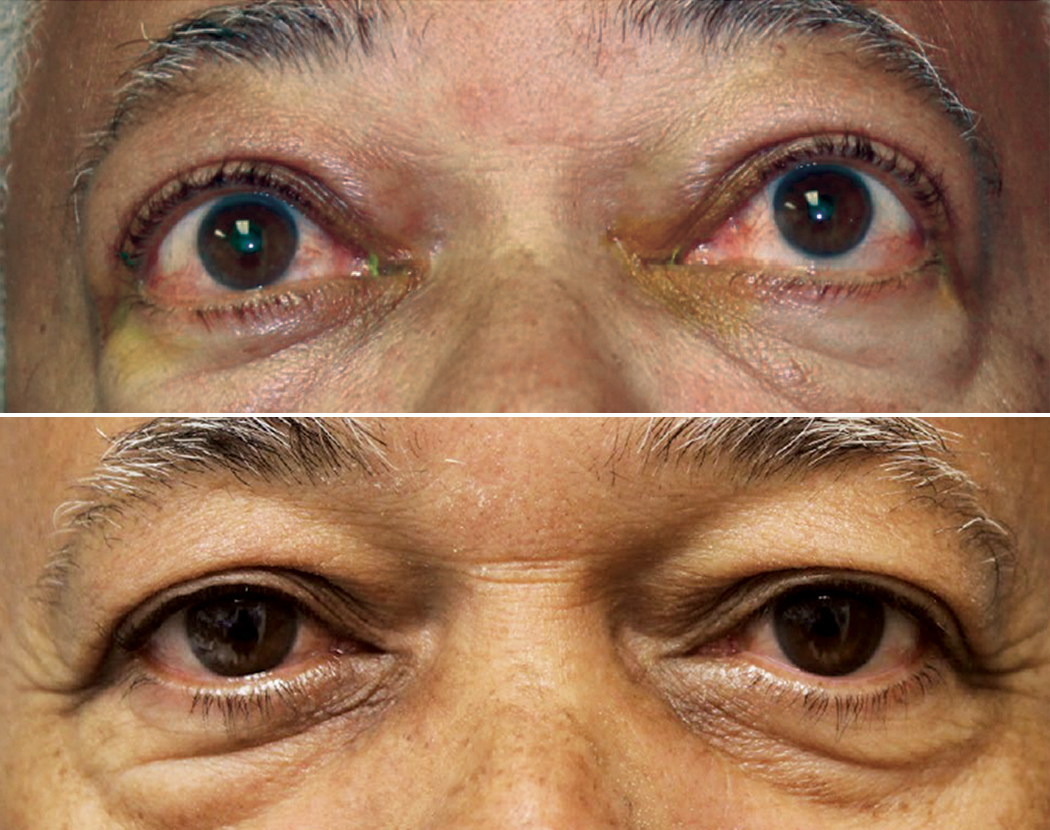 |
| A new study demonstrated that surgical decompression reduced proptosis by 1.5mm more than teprotumumab. Photo: Jacob Lang, OD. Click image to enlarge. |
Ocular proptosis is one of the most common features of thyroid eye disease (TED) for which patients routinely seek rehabilitation. Surgical decompression has been a mainstay of treatment for proptosis, while teprotumumab—administered intravenously—is a relative newcomer and the first nonsurgical option to reduce this symptom. Although both decompression and teprotumumab have demonstrated efficacy individually, a new study aimed to compare the clinical outcomes of the treatments when used separately or sequentially.
This was a nonrandomized study including 139 patients placed into four groups: decompression only, teprotumumab only, teprotumumab first with decompression later, and decompression first with teprotumumab later. The primary outcome was change in exophthalmometry, and secondary outcomes included change in extraocular motility, strabismus, diplopia and side effects.
The study found the greatest change in proptosis occurred in the decompression-only group (3.5mm), compared to 2.0mm in the teprotumumab-only group at late follow-up. Patients treated sequentially with either teprotumumab or decompression achieved a similar proptosis reduction effect as that therapy alone. As it related to secondary outcomes, the teprotumumab group had a significantly greater improvement in extraocular muscle restriction (14.7 degrees) vs. the decompression group (2.6 degrees). Neither treatment appeared to have an overall effect on strabismus, according to the study.
The authors posited that the combination of decompression and teprotumumab appears to be additive when compared to using treatments alone, however only 11 patients received both treatments. “The sample size limits the capacity to comment on the relative efficacy of a particular sequence of decompression and teprotumumab,” explained the authors.
They cite the heterogeneous patient population and nonrandomized approach as notable limitations in their study. “This has led to bias in the samples,” the authors said. “The reported differences at baseline may be related to a preferential selection of patients presenting with diplopia and restriction towards therapy with teprotumumab. Such a bias could be reasonable in clinical practice, given the improvement in motility noted with teprotumumab relative to decompression. Attempts to mitigate this bias through multivariate models controlling for baseline differences did not significantly change the results of the study, though it would be ideal to randomly assign group status in future studies.”
The authors reminded clinicians to consider the complex patient- and treatment-related factors of TED to determine the most appropriate course of action, and concluded, “if one treatment is insufficiently effective, it’s reasonable to use the other treatment sequentially.”
Hubschman S, Sojitra B, Ghiam S, et al. Teprotumumab and orbital decompression for the management of proptosis in patients with thyroid eye disease. Ophthalmic Plast Reconstr Surg, 2023. Epub ahead of print. |


